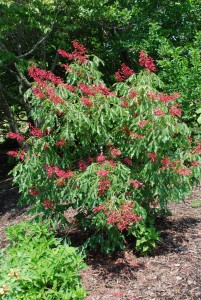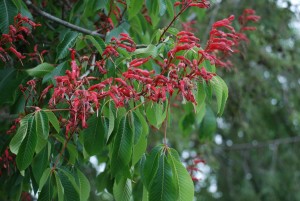Red buckeye (Aesculus pavia) is a southeastern U. S. native that has become more recognized as a wonderful small landscape tree (USDA hardiness zones 4-8). In its native habitat it is an understory large shrub or small tree frequently surrounded by taller trees or structures. A mature specimen may grow 20-25 feet high and wide in 30 years.
Showy, erect, 4-10 inch long panicles of red to orange-red flowers appear in spring. Many 5- to 9- inch long tubular flowers stand erect on branch tips as decorative candles in late April and May in zone 6. Flowers open at the same time the palmate leaves emerge. Flower tint may vary from dark pink to deep red on individual buckeyes growing next to one another. A rare yellow flower form, listed as A. pavia var. flavescens, is offered by a few specialty plant nurseries. Hummingbirds and butterflies pollinate individual flowers.
Red buckeye grows in average, moist, well-drained soil, and in full morning/afternoon shade or in all-day partial sunlight. The tree holds up to lots of shade although flower numbers are less. Spring feeding with granular 10-10-10 or equivalent fertilizer plus the addition of 2-3 inches of a fresh organic mulch are highly recommended. Soil moisture is of key importance. Summer foliage tends to scorch and declines sooner in dry warm conditions. In southern climes all-afternoon shade is the rule!
Attractive glossy, dark green, palmately compound leaves are attractive in spring and early summer. Disease and pest problems prove to be of little consequence, except that scorched and disease spotted foliage have dropped by September 1st and branches are mostly bare.
Smooth orange-brown seed husks contain 1-3 shiny seeds (1-2 inch long nutlets). Seeds are called “buckeyes” and ripen by early fall. New plants can be grown from seeds. They should be planted immediately and not allow to dry out prior to sowing. Seedlings often flower 3-4 years later. Seeds are poisonous and are rejected by most wildlife.



 Posted in
Posted in 
